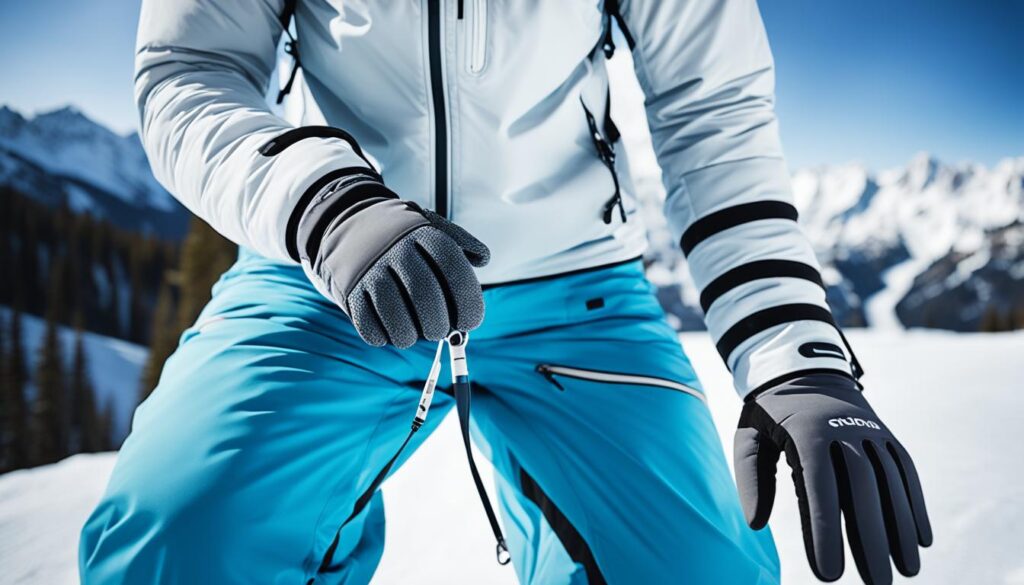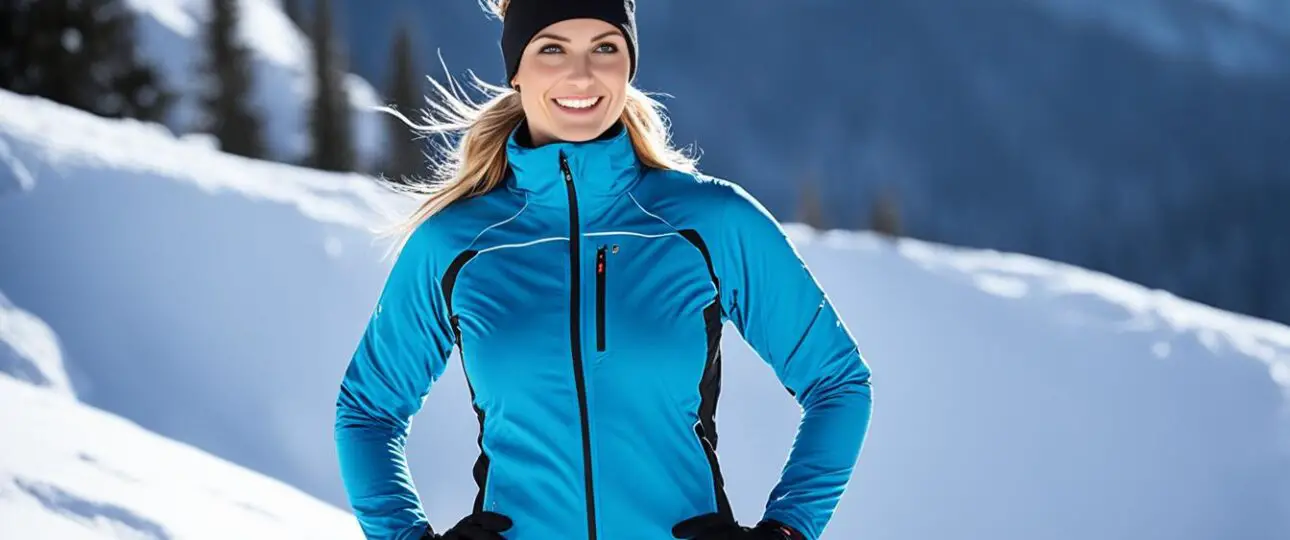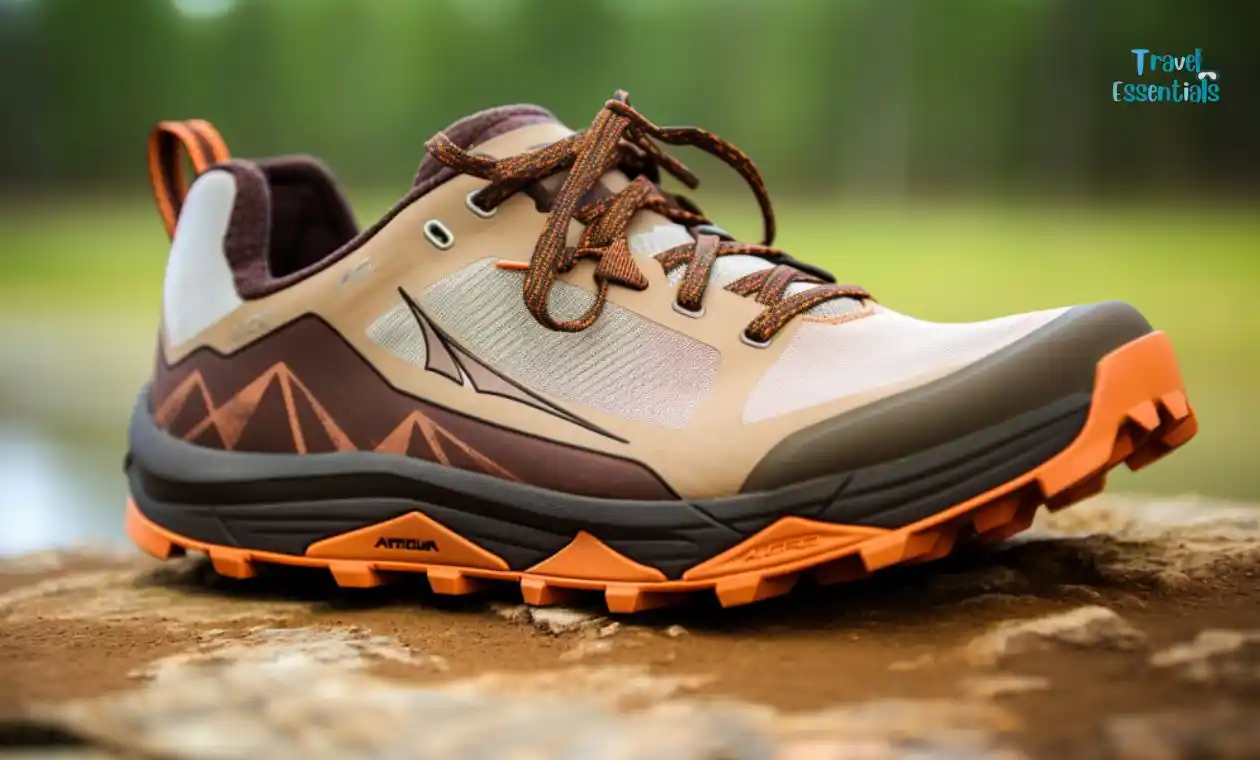When participating in winter sports like skiing or snowboarding, it is important to know what to wear under your snow pants to stay warm and comfortable. The layers you choose can make a big difference in regulating your body temperature and allowing for ease of movement on the slopes. Here’s a comprehensive guide on what to wear under snow pants for optimal warmth and flexibility.
Key Takeaways
- Choosing the right base layer is crucial for staying warm and comfortable while skiing or snowboarding.
- Thermal leggings are an excellent choice for providing insulation and flexibility.
- Layering is essential for managing body temperature and moisture.
- Consider the weather conditions and select suitable insulating layers.
- Don’t forget to wear moisture-wicking undergarments to keep dry during snow activities.
Understanding the basics of ski clothing, including the purpose and features of snow pants, is essential for choosing the right layers to wear underneath. Ski pants, also known as snow pants, are specialized trousers designed to keep you warm, dry, and protected during winter sports activities. Unlike regular pants, snow pants are made from water-resistant or waterproof materials to guard against snow and wind.
Understanding the Basics of Ski Clothing
When it comes to participating in winter sports activities, having the right clothing is essential. Ski pants, also known as snow pants, are specially designed trousers that offer protection from the elements while keeping you warm and dry. Unlike regular pants, snow pants are made from water-resistant or waterproof materials to guard against snow and wind. They are an indispensable part of any winter sports outfit.
Whether you’re hitting the slopes for skiing, snowboarding, or any other winter activity, having quality ski pants is crucial. These pants provide insulation, durability, and reliable protection against the cold and wet conditions you may encounter. Understanding the basics of ski clothing, including the purpose and features of snow pants, is key to selecting the right layers to wear underneath for maximum comfort and performance.
The Importance of Layering Under Ski Pants
When it comes to enjoying cold outdoor activities like skiing or snowboarding, proper layering is essential. While your outermost layer may be snow pants, the layers you wear underneath play a crucial role in maintaining optimum body temperature. Base layers, such as thermal underwear or long johns, are key components for managing your body temperature and moisture while skiing. They provide insulation and help regulate heat, ensuring both comfort and flexibility on the slopes.
Layering under ski pants is vital for several reasons. Firstly, it allows you to adjust your clothing according to the changing weather conditions and your activity level. By wearing multiple layers, you can add or remove items as needed to maintain a comfortable body temperature. This versatility ensures that you are prepared for any weather and can adapt to the demands of your winter sports activities.
Secondly, layering helps manage moisture and sweat. As you engage in high-energy activities such as skiing, your body naturally produces heat, leading to perspiration. Base layers made of moisture-wicking materials, such as synthetic fabrics or merino wool, help move sweat away from your skin, keeping you dry and preventing you from feeling clammy or chilled.
Lastly, layering provides added insulation. Each layer of clothing traps a layer of air, which acts as insulation to keep you warm. The more efficient your layering system is, the better it will be at retaining heat and keeping cold air out. Base layers are particularly important as they are in direct contact with your skin and create a warm and dry microclimate next to your body.
To visualize the layering process, refer to the table below:
| Layer | Function | Example |
|---|---|---|
| Base Layer | Moisture management and insulation | Thermal underwear or long johns |
| Mid Layer | Additional insulation and flexibility | Fleece pants or sweaters |
| Outer Layer | Protection against wind and snow | Ski pants and jacket |
| Accessories | Extra warmth and protection | Hats, gloves, and neck gaiters |
Layering under ski pants is a crucial step in staying warm, dry, and comfortable while enjoying winter sports activities. By investing in high-quality base layers and following a strategic layering system, you can effectively manage your body temperature and ensure an enjoyable experience on the slopes.
Essential Base Layers Under Ski Pants
When it comes to staying warm and comfortable while skiing, selecting the right base layers is essential. The base layers serve as the foundation of your outfit, providing insulation and moisture-wicking properties to manage sweat while on the slopes.
One popular choice for base layer bottoms is thermal underwear, also known as long johns. These snug-fitting garments are designed to fit closely against the skin, trapping body heat and providing an extra layer of insulation. Additionally, thermal underwear is made from moisture-wicking fabric, which effectively pulls sweat away from the body, keeping you dry and comfortable throughout your winter sports activities.
By wearing thermal underwear as your base layer under ski pants, you can maintain an optimal body temperature while enjoying a full range of motion on the slopes. The moisture-wicking fabric helps manage sweat, preventing it from lingering against your skin and causing discomfort.
Take a look at the table below for a comparison of popular base layer brands and their key features:
| Brand | Material | Moisture-Wicking | Insulation |
|---|---|---|---|
| Brand X | Merino Wool | Yes | Excellent |
| Brand Y | Polyester | Yes | Good |
| Brand Z | Blend of Merino Wool and Polyester | Yes | Excellent |
Choosing the Right Base Layer
When selecting base layers for ski pants, consider the following factors:
- Material: Choose a base layer made from moisture-wicking fabric, such as merino wool or polyester, to keep sweat at bay and maintain comfort.
- Insulation: Look for base layers that provide sufficient insulation to keep you warm without feeling bulky.
- Fit: Opt for a snug fit that allows for easy layering and freedom of movement.
By investing in high-quality base layers, you can ensure that you stay dry, warm, and comfortable while skiing or snowboarding. Remember to layer appropriately based on the weather conditions and adjust accordingly throughout the day to maintain your optimal body temperature.

Stay tuned for the next section, where we’ll discuss how to pick the right material for your base layers.
Picking the Right Material for Your Base Layers
Choosing the right material for your base layers is essential for comfort and warmth. The fabric you select can make a significant difference in your overall skiing or snowboarding experience. Two popular options for base layers are merino wool and polyester. Let’s explore their features and benefits to help you make an informed decision.
Merino Wool Base Layers
Merino wool is renowned for its exceptional insulation properties and ability to wick away moisture. It is a natural fiber derived from merino sheep, known for its softness and comfort against the skin. Merino wool base layers offer excellent warmth, even when wet, making them an ideal choice for cold weather conditions. Additionally, merino wool is naturally odor-resistant, keeping you fresh even after a long day on the slopes.
Polyester Base Layers
Polyester base layers are lightweight and quick-drying, making them a popular choice for winter sports enthusiasts. Polyester is a synthetic fabric that efficiently manages moisture by pulling sweat away from the skin and allowing it to evaporate quickly. This moisture-wicking property helps keep you dry and comfortable during intense physical activities. Polyester base layers are also durable and easy to care for, making them a convenient option.
When deciding between merino wool and polyester base layers, consider the following factors:
- Insulation: Merino wool provides exceptional insulation, even when wet, while polyester base layers offer lightweight warmth.
- Moisture Management: Both materials excel in moisture management, with merino wool absorbing and releasing moisture and polyester wicking away sweat.
- Personal Preference: Some individuals prefer the natural feel and odor-resistant properties of merino wool, while others appreciate the quick-drying nature and durability of polyester.
- Weather Conditions: Consider the specific weather conditions for your ski day. Merino wool is an excellent choice for extremely cold temperatures, while polyester may be more suitable for milder climates.
Ultimately, the choice between merino wool and polyester base layers depends on your personal preference and the specific conditions of your winter sports adventure. Regardless of the material you choose, remember to select base layers that fit snugly against your skin to maximize their insulating and moisture-wicking properties.

Socks and Mid Layers Under Ski Pants
In addition to base layers, wearing the right socks and mid layers under ski pants can provide additional warmth and comfort for your winter sports activities. Investing in socks specifically designed for winter sports, such as skiing, can make a significant difference in your comfort level on the slopes. Look for socks that offer firm compression and ensure a snug fit without restricting circulation. These socks help improve blood flow and reduce fatigue, allowing you to ski longer without discomfort.
When it comes to mid layers, fleece pants are a top choice for added warmth and comfort under your ski pants. Fleece is known for its excellent insulation properties, trapping heat close to your body to keep you warm in cold weather conditions. Additionally, fleece is soft and comfortable, allowing for unrestricted movement on the slopes. Whether you opt for lightweight fleece pants or thicker options, they provide an extra layer of warmth and coziness, making your skiing or snowboarding experience more enjoyable.
By combining the right socks and mid layers with your base layers and snow pants, you can achieve optimal warmth and comfort during your winter sports adventures. These additional layers help regulate body temperature and provide insulation, ensuring you stay cozy and dry on the slopes. Remember, every layer you add contributes to the overall effectiveness of your outfit, so choose high-quality socks and fleece pants to enhance your winter sports experience.
Managing Moisture and Perspiration
Moisture and perspiration management are crucial when participating in winter sports. The base layer fabric plays a significant role in this process. Wicking fabric, like Merino wool, absorbs moisture from the skin and releases it to the outside, keeping your body temperature regulated and your clothing dry. Breathable fabrics, such as polyester and Merino wool, are ideal for base layers as they allow sweat and heat to escape, improving overall body comfort during skiing or snowboarding.
When it comes to staying comfortable and dry while enjoying winter sports, choosing the right base layer fabric is key. Here’s a closer look at the benefits of wicking fabrics and breathability:
| Wicking Fabric | Breathability |
|---|---|
| Absorbs moisture from the skin | Allows sweat and heat to escape |
| Keeps the body temperature regulated | Improves overall body comfort |
| Prevents sweat from accumulating | Reduces the risk of overheating |
Wicking fabrics, such as Merino wool, are known for their superior moisture management capabilities. They have the ability to pull sweat away from the skin, preventing it from lingering and causing discomfort. This moisture is then released to the outer layers, where it can evaporate more easily.
In contrast, breathable fabrics like polyester and Merino wool allow air to circulate through the fabric, promoting ventilation and allowing heat and moisture to escape. This prevents the buildup of sweat and helps regulate body temperature, keeping you cool when you start to heat up and warm when the temperature drops.
When selecting base layers for your winter sports attire, prioritize wicking fabric and breathability. These features will ensure that you stay dry, comfortable, and ready to tackle the slopes with ease.
Conclusion
When it comes to staying warm and comfortable on the slopes, choosing the right layers to wear under your snow pants is essential. Base layers, such as thermal underwear, play a crucial role in managing body temperature and moisture while skiing or snowboarding. They provide insulation and help regulate heat, keeping you cozy throughout your winter sports activities.
When selecting base layer materials, consider options like Merino wool or polyester, which offer excellent insulation and moisture management. Merino wool is known for its warmth and natural wicking properties, while polyester is lightweight and quick-drying. Both fabrics contribute to keeping you dry and comfortable during your ski adventures.
In addition to base layers, incorporating mid layers like fleece pants can provide extra warmth and comfort. These layers add insulation while maintaining breathability, ensuring you stay cozy without feeling overheated. Don’t forget about your feet – investing in moisture-wicking socks specifically designed for winter sports can enhance your overall comfort and prevent discomfort caused by sweat and moisture.
Remember, the ultimate goal is to enjoy your time on the slopes while staying warm, dry, and comfortable. Take into account personal preferences and specific weather conditions when deciding what to wear under your snow pants. By selecting the right layers for your winter sports activities, you can optimize your experience and have a fantastic time in the snow!



